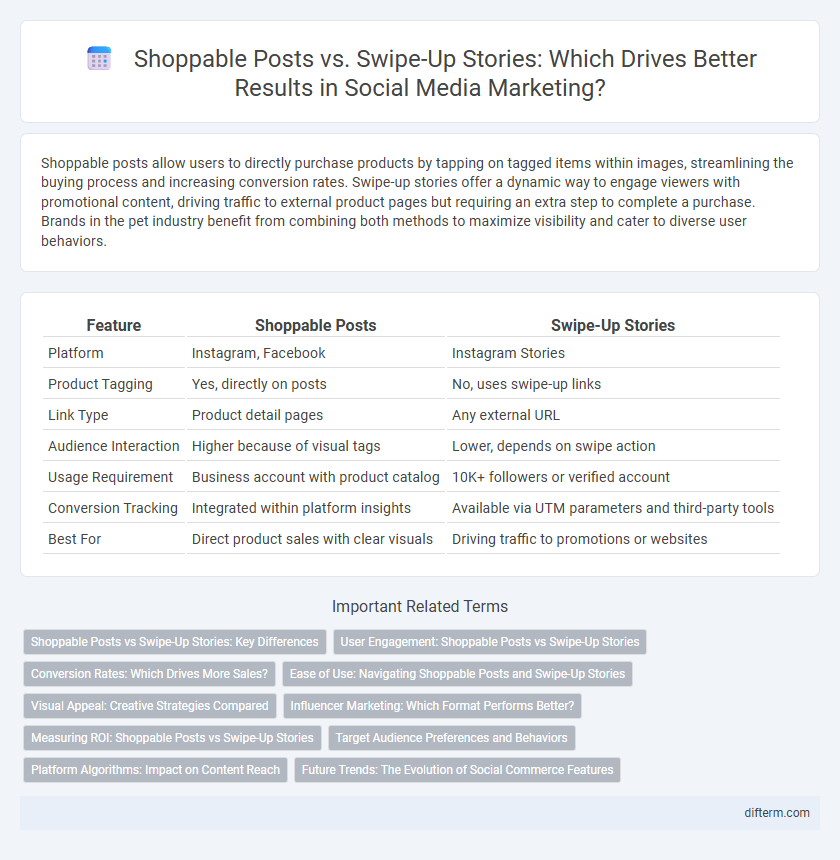Shoppable posts allow users to directly purchase products by tapping on tagged items within images, streamlining the buying process and increasing conversion rates. Swipe-up stories offer a dynamic way to engage viewers with promotional content, driving traffic to external product pages but requiring an extra step to complete a purchase. Brands in the pet industry benefit from combining both methods to maximize visibility and cater to diverse user behaviors.
Table of Comparison
| Feature | Shoppable Posts | Swipe-Up Stories |
|---|---|---|
| Platform | Instagram, Facebook | Instagram Stories |
| Product Tagging | Yes, directly on posts | No, uses swipe-up links |
| Link Type | Product detail pages | Any external URL |
| Audience Interaction | Higher because of visual tags | Lower, depends on swipe action |
| Usage Requirement | Business account with product catalog | 10K+ followers or verified account |
| Conversion Tracking | Integrated within platform insights | Available via UTM parameters and third-party tools |
| Best For | Direct product sales with clear visuals | Driving traffic to promotions or websites |
Shoppable Posts vs Swipe-Up Stories: Key Differences
Shoppable posts enable direct product purchases within the Instagram feed, enhancing seamless shopping experiences by integrating product tags and pricing information. Swipe-up stories require users to swipe up to visit external links, redirecting traffic to websites but interrupting in-app engagement. Shoppable posts drive higher conversion rates by reducing friction in the buyer journey compared to swipe-up stories.
User Engagement: Shoppable Posts vs Swipe-Up Stories
Shoppable posts generate higher user engagement by allowing users to directly purchase products without leaving the feed, streamlining the shopping experience and reducing friction. Swipe-up stories require users to take an additional step to access product links, often resulting in lower click-through rates and decreased interaction. Platforms like Instagram report that shoppable posts increase conversion rates by up to 70% compared to swipe-up links, emphasizing their effectiveness in driving user actions.
Conversion Rates: Which Drives More Sales?
Shoppable posts generate higher conversion rates than swipe-up stories by enabling direct product purchases within the feed, reducing friction in the buyer journey. Studies indicate that shoppable posts can increase sales by up to 30% compared to swipe-up stories, which often require an additional step to access the shop. Brands focusing on seamless customer experiences benefit from shoppable posts due to their higher engagement and immediate call-to-action features.
Ease of Use: Navigating Shoppable Posts and Swipe-Up Stories
Shoppable posts simplify user experience by allowing direct product purchases within the feed, reducing friction in the buying process. Swipe-up stories require users to navigate to a separate webpage, which can interrupt engagement and increase drop-off rates. Brands seeking seamless conversions prioritize shoppable posts for their intuitive and effortless shopping interface.
Visual Appeal: Creative Strategies Compared
Shoppable posts leverage high-quality images and product tags to create a seamless buying experience directly within the feed, maximizing visual impact and ease of access. Swipe-up stories rely on engaging, ephemeral content and dynamic animations to capture attention and drive traffic through quick calls-to-action. Both strategies prioritize visually compelling content but differ in their interaction style and user engagement timing.
Influencer Marketing: Which Format Performs Better?
Shoppable posts generate higher engagement rates in influencer marketing by allowing direct purchasing without leaving the platform, simplifying the consumer journey. Swipe-up stories offer time-limited exposure but often result in lower conversion rates due to the extra step of redirecting followers to external sites. Data shows shoppable posts outperform swipe-up stories in driving both brand awareness and sales, especially among Gen Z and millennial audiences.
Measuring ROI: Shoppable Posts vs Swipe-Up Stories
Measuring ROI for shoppable posts reveals higher engagement rates and conversion tracking accuracy compared to swipe-up stories, thanks to built-in product tags and seamless checkout processes. Swipe-up stories often lack direct attribution tools, making it challenging to quantify sales impact and user behavior. Businesses leveraging shoppable posts report improved analytics integration and increased revenue visibility, enhancing overall marketing effectiveness.
Target Audience Preferences and Behaviors
Shoppable posts enable direct product purchases within the feed, catering to audiences who prefer seamless, immediate shopping experiences without navigating away. Swipe-up stories appeal to users inclined toward exploratory behaviors, providing detailed content and external links that engage viewers before purchase decisions. Understanding target audience preferences for instant versus informative interactions optimizes marketing strategies across social platforms.
Platform Algorithms: Impact on Content Reach
Platform algorithms prioritize shoppable posts by integrating product tags directly within the feed, enhancing visibility and engagement through seamless user interaction. Swipe-up stories, while offering quick access to external links, often experience limited reach due to their ephemeral nature and reduced algorithmic favorability compared to permanent feed content. Understanding these algorithmic biases is crucial for marketers aiming to maximize content reach and conversion rates on social media platforms like Instagram and TikTok.
Future Trends: The Evolution of Social Commerce Features
Shoppable posts are evolving with AI-driven personalization and augmented reality integration, allowing consumers to engage instantly and make purchases directly within social media feeds. Swipe-up stories are transforming into interactive, in-app checkout experiences that reduce friction and boost conversion rates. Future trends emphasize seamless, immersive social commerce features that blend content consumption with real-time shopping opportunities.
Shoppable posts vs swipe-up stories Infographic

 difterm.com
difterm.com